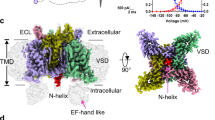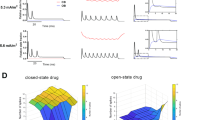Abstract
Effects of a kava-pyrone (±)-kavain on fast inactivation of Na+ channels were studied in experiments on isolated neurons from the rat hippocampus. (±)-Kavain was found to block Na+ channels, and its effect was voltage-dependent. At the holding potentials of −100 and −80 mV, IC50 for (±)-kavain was 744.9 and 178.8 µM, respectively. The inactivation characteristic of Na+ channels was satisfactorily described with the Boltzmann's equation both in the control and under (±)-kavain application. (±)-Kavain at a 330 µM concentration shifted theV 1/2 toward more negative values by 14.4 mV and concurrently modified the slope factor: the latter was 5.7 mV in the control, while under the influence of 330 µM (±)-kavain it reached 6.7 mV. In agreement with Hille's hypothesis of a “modulated receptor,” inactivated Na+ channels demonstrated an increased sensitivity to kavain. (±)-Kavain effects resulted in an increase in the rate of depolarization-related fast inactivation, while the process of recovery from inactivation became slower when the membrane was hyperpolarized. Our data show that under the (±)-kavain effect the probability of the inactivated state of Na+ channels increases, and the state of fast inactivation is stabilized.
Similar content being viewed by others
References
J. Urenjak and T. P. Obrenovitch, “Pharmacological modulation of voltage-gated Na+ channels: a rational and effective strategy against ishemic brain damage,”Pharmacol. Rev.,48, No. 1, 21–67 (1996).
C. P. Taylor and B. S. Meldrum, “Na+-channels as targets for neuroprotective drugs,”,TIPS,16, 309–316 (1995).
H. J. Meyer, “Pharmacology of kava,” in:Ethnopharmacologic Search for Psychoactive Drugs, D. H. Efron, B. Holmstedt, and N. S. Kline (eds.), Raven Press, New York (1979), pp. 133–140.
V. Lebot, M. Merlin, and L. Lindstrom,Kava. The Pacific Drug, Yale Univ. Press, New Haven (1992).
Y. N. Singh, “Kava: an overview,”J. Ethnopharmacol.,37, 13–45 (1992).
J. Gleitz, A. Beile, and T. Peters, “(±)-Kavain inhibits veratridine-activated voltage-dependent Na+-channels in synaptosomes prepared from rat cerebral cortex,”Neuropharmacology,34, 1133–1138 (1995).
J. Gleitz, A. Beile, and T. Peters, “(±)-Kavain inhibits veratridine- and KCl-induced increase in intracellular Ca2+ and glutamate-release of rat cerebrocortical synaptosomes,”Neuropharmacology,35, 179–186 (1996).
D. Schmitz, C. L. Zhang, and S. S. Chatterjee, “Effects of methysticin on three different models of seizure-like events studied in rat hippocampal and entorhinal cortex slices,”Naunyn-Schmiedeberg's Arch. Pharmacol.,351, 348–355 (1995).
V. A. Panchenko, J. Pintor, A. Ya. Tsyndrenko, et al., “Diadenosine polyphosphates selectively potentiate N-type Ca2+-channels in rat central neurons,”Neuroscience,70, No. 2, 353–360 (1996).
O. A. Krishtal, S. M. Marchenko, and V. I. Pidoplichko, “Receptor for ATP in membrane of mammalian sensory neurones,”Neurosci. Lett.,35, 41–45 (1983).
N. I. Kiskin, I. V. Chizhmakov, A. Ya. Tsyndrenko, et al., “R56865 and flunarizine as Na+-channel blockers in isolated Purkinje neurons of rat cerebellum,”Neuroscience,54, No. 3, 575–585 (1993).
R. W. Tsien and D. Noble, “A transition state theory approach to the kinetics of conductance changes in excitable membranes,”J. Membrane Biol.,1, No. 2, 248–273 (1969).
A. L. Hodgkin and A. F. Huxley, “The dual effect of membrane potential on sodium conductance in the giant axon ofLoligo,”J. Physiol.,116, 497–506 (1952).
W. A. Catterall, “Common modes of drug action on Na+ channels: local anesthetics, anti-arrhythmics and anti-convulsants,”TIPS,8, 57–65 (1987).
C. Quan, W. M. Mok, and G. K. Wang, “Use-dependent inhibition of Na+ currents by benzocaine homologs,”Biophys. J.,70, Jan., 194–201 (1996).
J. Patlak, “Molecular kinetics of voltage-dependent Na+ channels,”Physiol. Rev.,71, 1047–1080 (1991).
J. C. McPhee, D. S. Ragsdale, T. Scheuer, and W. A. Catterall, “A critical role for transmembrane segment IVS6 of the sodium channelα subunit in fast inactivation,”J. Biol. Chem.,270, No. 20, 12025–12034 (1995).
C. M. Armstrong and F. Bezanilla, “Inactivation of the sodium channel. II. Gating current experiments,”J. Gen. Physiol.,70, 567–590 (1977).
F. Bezanilla and C. M. Armstrong, “Inactivation of the sodium channel. I. Sodium current experiments,”J. Gen. Physiol.,70, 549–566 (1977).
R. W. Aldrich, D. P. Corey, and C. F. Stevens, “A reinterpretation of mammalian sodium channel gating based on single channel recording,”Nature,306, 436–441 (1983).
L. Goldman and C. L. Schauf, “Inactivation if the sodium current inMyxicola giant axons: evidence for coupling to the activation process,”J. Gen. Physiol.,59, 659–675 (1972).
C. M. Armstrong, “Sodium channels and gating currents,”Physiol. Rev.,61, 644–683 (1981).
B. Hille, “Local anesthetics: hydrophilic and hydrophobic pathways for the drug-receptor reaction,”J. Gen. Physiol.,69, 497–515 (1977).
B. P. Bean, C. J. Cohen, and R. W. Tsien, “Lidocain block of cardiac sodium channels,”J. Gen. Physiol.,81, 613–642 (1983).
Author information
Authors and Affiliations
Additional information
Neirofiziologiya/Neurophysiology, Vol. 28, No. 4/5, pp. 218–224, July–October, 1996.
Rights and permissions
About this article
Cite this article
Magura, E.I. Effects of (±)-kavain on inactivation of voltage-operated Na+ channels. Neurophysiology 28, 173–177 (1996). https://doi.org/10.1007/BF02262780
Received:
Issue Date:
DOI: https://doi.org/10.1007/BF02262780




